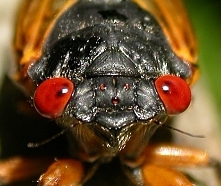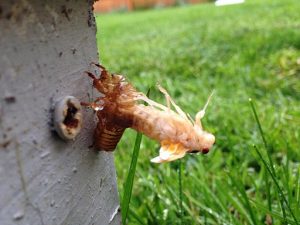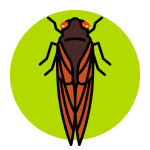A great transformation is about to take place in the world around you. The skies will fill with thousands of strange, buzzing insects, the “Great Eastern Brood” of cicadas, known as Brood X—pronounced Brood Ten. Even if you don’t see a live cicada, you may find its shed skin on the ground or the side of a tree, empty and translucent. Although these insects only appear for a few weeks before dying, they are an important part of our ecosystem, providing food for many animals in the year they emerge and altering the growth pattern of trees in the prior year. Read on to learn about the mysterious lives of the 17-year cicadas and how you can track Brood X!
The Nature of Cicadas
Cicadas are sometimes called “locusts” because of their tendency to appear in large numbers. Conflating cicadas with locusts is an old tradition that goes back to America’s colonial days, when the settlers thought they were living through the Plague of Locusts as the cicada broods emerged. All cicada species outside North America are considered “annual cicadas,” which means some of them emerge each year rather than all appearing in one massive brood. Brood X is made up of periodical cicadas, which have a long and unique life cycle that sets them apart from other insects.
Cicadas are not closely related to locusts and don’t live like them at all. They don’t eat solid food; their specialized mouths are designed to suck juices from shrubs and trees. Over 90 percent of the lives of Brood X are spent as nymphs. In this form, they have no wings and live underground, sucking the sap from tree roots. Nymphs will slowly grow larger and seek out bigger roots to feed from underground over the course of 17 years until they finally emerge from the earth, shed their skin, and become adults.
As winged adults, cicadas will no longer eat much, feeding only lightly on juices from branches and twigs. Almost all their attention goes into attempts at finding a mate. To attract a female, males vibrate a ridged organ called a tymbal on their abdomen. This organ exists only on the males and is more likely to attract a female based on how much noise it produces. Hundreds of males get together in trees and join to produce a louder song in hopes of attracting females. The song of the male cicadas is the loudest of all insect calls, registering at roughly 100 decibels. After mating, the female will lay her eggs in small grooves in a plant stem. These will eventually hatch into more tiny nymphs, and another 17-year cycle will begin.
Finding Brood X
Because they eat relatively little and expend much energy flying around and making noise, adult cicadas don’t live very long—about 4 to 6 weeks before dying. Once Brood X emerges, you only have a small window of time to find and see them! There are some resources that will make this easier. The Cicada Safari page provides some important information and pictures of the periodical cicadas, as well as a link to the Cicada Safari app that you can download for iPhones and Android phones. This app is an important tool in helping find the locations of Brood X cicadas. You can find, map, and help others locate Brood X with the Cicada Safari app!
To use Cicada Safari, download it to your smartphone, then go exploring in the forests and parks around our area. When you find a tree or shrub with cicadas on it, take a picture. The map will automatically record where you were, allowing others to know that Brood X exists in that specific area. As more reports come in from other places in Virginia, the range and distribution of Brood X can be better determined. The distribution of cicada broods can be spotty and uneven in a given area, making this precise mapping technology very important to discovering the places and limits of Brood X’s range.





